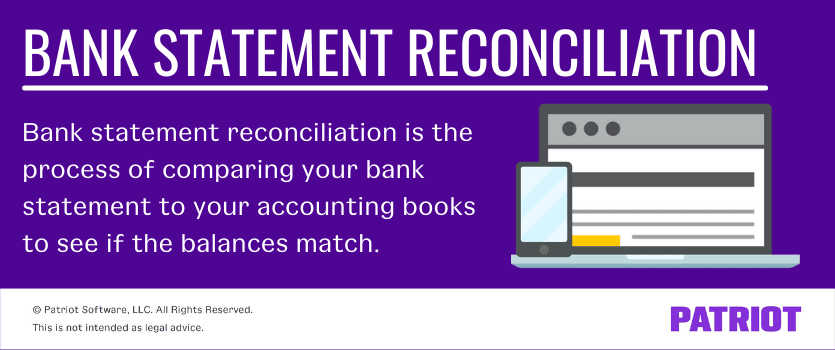Your books say one thing, but your bank statement says another. Sigh (why isn’t anything ever easy?!). But don’t stress—bank statement reconciliation is here to help.
Sure, managing your business bank account may not be the first thing on your to-do list. But, bank statement reconciliation helps you catch and correct errors before they damage your finances.
Read on to learn what is bank statement reconciliation, why it matters, and how to do it.
Bank statement reconciliation: What is it?
Bank statement reconciliation is the process of comparing your bank statement to your accounting books.

Here’s how it works. Typically, you record check and cash transactions in a check register, which is part of your general ledger. The bank has a similar record of your business checking account. The bank issues you a statement to reflect all activity in the account each month.
When you receive your statement, match the transactions to your books to see if they are equal.
Often (and unfortunately for business owners everywhere), they’re not. Slight discrepancies, like forgetting to record a transaction or getting hit with bank service fees, ruin a good thing. Not to mention, timing is everything. You may enter a transaction in your books that doesn’t show up on your bank statement until the next month (or vice versa).
Checking your bank statement against your register helps you to square away discrepancies for accurate recordkeeping.
Why is it important to reconcile your bank statements?
Bank statement reconciliation: Who cares? The IRS, investors, lenders, and business owners care about accurate and up-to-date books. Reconciling your bank statement with your books helps get you there. Through reconciliation, you can get a complete and precise understanding of your business’s financial health.
OK, OK, so bank statement reconciliation is pretty essential. But what are the objectives of preparing bank reconciliation?
Reconciling your bank statement helps you to:
- Spot errors you made in your books (e.g., calculation or recordkeeping errors)
- Identify mistakes made by the bank
- Detect fraudulent transactions
- Update your books to include extras, like bank fees
- Stay on top of your accounts receivable and payable
Do bank statement reconciliation regularly (e.g., each time your bank account cycle ends) to spot errors before they snowball.
How to do a bank statement reconciliation
Nervous about the reconciliation of bank statement process? If you’ve never reconciled a bank statement, doing so for the first time can be intimidating. But, you can think of it as a simple matching process.
To reconcile bank statement, you must:
- Compare your bank statement and business records
- Make adjustments
- Compare your adjusted balances
Bank statement reconciliation requires you to track your business’s transactions in organized accounting books. You can also make the process easier by opening a separate business bank account.
1. Compare your bank statement and business records
Compare the transactions in your bank statement to your business records for the same period. Your statement and business records should have the same number of transactions. And, each line item in your statement should match a line item in your records.
But, it’s common for the balance in your bank statement and books not to match (which is why you’re going through this process!).
So if your bank statement and business records don’t match, don’t panic. Identify the line items that don’t add up. These may be due to:
- Deposits in transit
- Outstanding checks
- Bank service fees
- Non-sufficient funds (NSF) checks
- Interest earned
2. Make adjustments
You may need to make adjustments to your bank statement, business records, or both. You can make “adjustments” through adjusting journal entries or by creating a separate bank reconciliation statement.
Either way, keep detailed records explaining why you’re reconciling your bank statement and books.
Adjust your bank statement
You may need to adjust your bank statement balance for transactions you recorded in your books that aren’t reflected on your bank statement. This may be due to transactions taking place too close to the statement date.
Two types of transactions that show up in your books but not your bank statement include:
- Deposits in transit
- Outstanding checks
Deposits in transit
Deposits in transit are checks your business received and recorded in your books but they aren’t reflected in your bank statement until the following month.
You might have accepted checks on the closing date of the bank statement and recorded them in your books. But if you deposited the checks later in the day, the transaction would not appear on the statement. Instead, it will appear on the next bank statement.
Increase the bank statement balance by the total deposits in transits. That way, the bank statement reflects the amount of cash in your account.
Outstanding checks
Outstanding checks are checks you wrote and recorded in your books, but they aren’t reflected in your bank statement until the following month.
If you wrote checks in recent days before the bank issued the statement, they might not have cleared the bank. But if you recorded them in your books, your records and bank statement won’t line up.
Adjust your bank statement to reflect the outstanding checks. Subtract the outstanding check amounts from the bank statement balance.
Adjust your business records
If your bank statement includes items you didn’t record in your books, you must adjust your records.
Types of transactions that show up in your bank statement but not your books include:
- Bank service fees
- NSF checks
- Interest earned
- Errors of omission
Bank service fees
Bank service fees are fees your bank charges that may appear on your bank statement but not in your books.
The bank charges you fees for processing your checking account activities. You may get fees for:
- Accepting deposits
- Electronic transfers
- ATM withdrawals
- Debit card transactions
- Overdrafts
- Stop payment orders
The bank deducts fees from your bank statement balance. But, you have not recorded the bank fees in your check register.
You need to adjust your books to correspond with the bank statement. Subtract bank fees from your books to match the bank statement balance.
NSF checks
NSF checks are checks you wrote that the recipient couldn’t cash because your account’s funds are too low. You may have recorded these in your business records, but your bank statement won’t reflect them because the check returns to you.
Your bank decreases your checking account by the amount of the NSF check (plus a fee). The deduction shows up on your bank statement.
Adjust your books to match the NSF check on the bank statement. Subtract the amount of the NSF check and the fees from your books.
Interest earned
Interest earned is interest that accrues on your bank account balance. The amount (generally insignificant, but enough to throw off your books) appears on your bank statement but not in your books.
Adjust your books to reflect the interest earned on your bank statement.
Errors of omission
Errors of omission happen when a transaction occurs, but you forget to record it in your books.
If an authorized transaction shows up on your bank statement (aka isn’t fraudulent), adjust your books to match the bank statement record. But if you see a suspicious charge that you can’t verify, contact your bank immediately.
3. Compare your adjusted balances
After you adjust your bank statement and business records, compare the balances. At this point, the two balances should be the same amount.
If the sums are different, go through each entry to find the discrepancy. Mark each verified entry as you go. Double-check each adjustment to make sure you document every transaction in both records. Your bank can help you find and correct errors if you need further help.
Once the balances match, they should reflect an accurate, current picture of your bank account balance. And voila! You’ve eliminated surprises due to mismatched records.
This article was updated from its original publication date of February 18, 2015.
This is not intended as legal advice; for more information, please click here.



